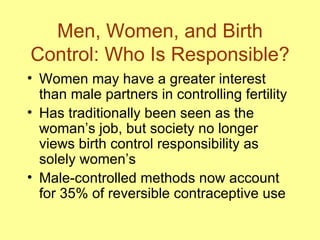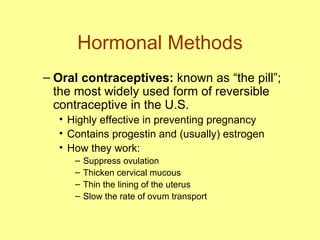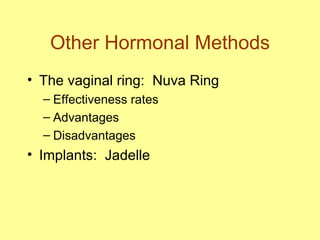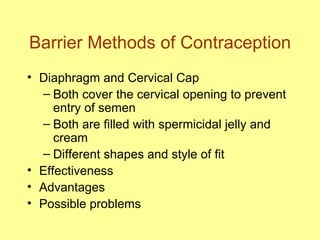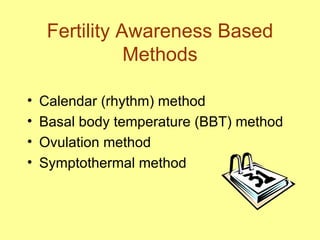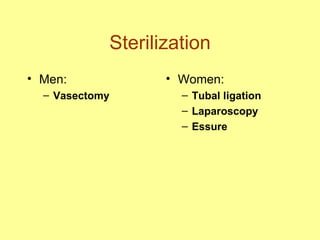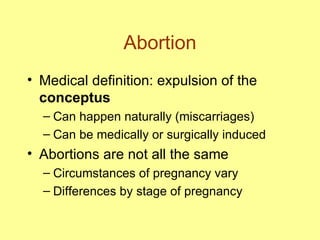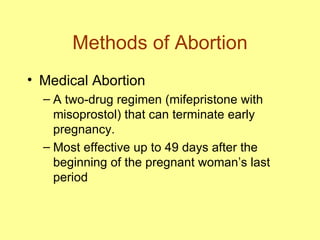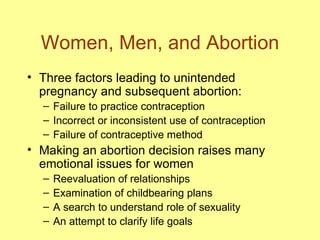strong6_ppt_ch11
- 1. Chapter Eleven Contraception and Birth Control
- 2. Risk and Responsibility In the United States, half of all pregnancies are unintended Half of unintended pregnancies occur in couples who do not use contraception Those who discuss preventing pregnancy are most likely to use contraceptives
- 3. Men, Women, and Birth Control: Who Is Responsible? Women may have a greater interest than male partners in controlling fertility Has traditionally been seen as the woman’s job, but society no longer views birth control responsibility as solely women’s Male-controlled methods now account for 35% of reversible contraceptive use
- 4. Adolescents and Contraception Adolescents are less likely than older individuals to use contraction Condoms are preferred method Condom use may be stigmatized
- 5. Birth Control and Contraception: What’s the Difference? Birth control: any means of preventing a birth from taking place; includes contraception and abortion Contraception: birth control that works specifically to prevent conception
- 6. Choosing a Method Best method is the one you will use correctly and consistently Theoretical effectiveness assumes consistent and correct usage User effectiveness: Actual statistical effectiveness incorporating those who use method but do not do so consistently and correctly
- 7. Sexual Abstinence Most reliable form of birth control Involves refraining from sexual activity that could cause pregnancy Abstinence doesn’t necessarily rule out affection or non-coital sexual activities Practitioners’ definitions of abstinence vary From a contraceptive perspective, abstinence from vaginal intercourse is required
- 8. Hormonal Methods Oral contraceptives: known as “the pill”; the most widely used form of reversible contraceptive in the U.S. Highly effective in preventing pregnancy Contains progestin and (usually) estrogen How they work: Suppress ovulation Thicken cervical mucous Thin the lining of the uterus Slow the rate of ovum transport
- 9. Hormonal Methods The pill: Oral contraceptives Effectiveness rates Suppresses ovulation Multiple types Advantages Disadvantages Possible problems
- 10. Other Hormonal Methods Injectable contraceptives: Depo - Provera The Patch: Ortho Evra Effectiveness rates Advantages Disadvantages The vaginal ring: Nuva Ring
- 11. Other Hormonal Methods The vaginal ring: Nuva Ring Effectiveness rates Advantages Disadvantages Implants: Jadelle
- 12. Barrier Methods of Contraception Condom Spermicide: nonoxynol – 9 Latex vs. polyurethane Women and condom use Effectiveness and advantages Possible problems The female condom
- 13. Barrier Methods of Contraception Diaphragm and Cervical Cap Both cover the cervical opening to prevent entry of semen Both are filled with spermicidal jelly and cream Different shapes and style of fit Effectiveness Advantages Possible problems
- 14. Barrier Methods of Contraception Contraceptive sponge The FemCap Spermicide Foam Film Creams, jellies, and vaginal suppositories
- 15. Intrauterine Device (IUD) Tiny plastic or copper device inserted into uterus Multiple types currently available 10-12 years Not an abortifacient Projections for increased popularity
- 16. Fertility Awareness Based Methods Calendar (rhythm) method Basal body temperature (BBT) method Ovulation method Symptothermal method
- 17. Sterilization Men: Vasectomy Women: Tubal ligation Laparoscopy Essure
- 18. Emergency Contraception Taken within 120 hours of unprotected sex Plan B Concentrated doses of progestin and/or estrogen Can prevent pregnancy from occurring by stopping ovulation, fertilization, and implantation Will not abort an established pregnancy Different from “abortion pill” Copper IUD Less common method; interferes with implantation
- 19. Abortion Medical definition: expulsion of the conceptus Can happen naturally (miscarriages) Can be medically or surgically induced Abortions are not all the same Circumstances of pregnancy vary Differences by stage of pregnancy
- 20. Abortion Conditions matter Under safe, clean, legal conditions abortion is a safe medical procedure Self-administered or illegal clandestine abortions can be very dangerous, sometimes fatal
- 21. Methods of Abortion Medical Abortion A two-drug regimen (mifepristone with misoprostol) that can terminate early pregnancy. Most effective up to 49 days after the beginning of the pregnant woman’s last period
- 23. Methods of Abortion Surgical Abortion: vacuum aspiration Used in first trimester dilation and evacuation (D&E) Used in second trimester Only 1.5% of US abortions hysterotomy Used in later stages of pregnancy Like a cesarean section; extremely rare
- 24. Prevalence of Abortion A common experience among U.S. women Approximately half of unintended pregnancies end in abortion Highest rates among Ages 18-29, unmarried, Black or Hispanic, and/or economically disadvantaged women Number of abortions decreased between 1994 and 2000 Emergency contraception accounts for as much as 43% of decrease
- 25. Women, Men, and Abortion Three factors leading to unintended pregnancy and subsequent abortion: Failure to practice contraception Incorrect or inconsistent use of contraception Failure of contraceptive method Making an abortion decision raises many emotional issues for women Reevaluation of relationships Examination of childbearing plans A search to understand role of sexuality An attempt to clarify life goals
- 26. Women, Men, and Abortion Abortion can also raise many emotional issues for men Experience of guilt and anxiety Ambivalence about parenthood Powerlessness Not uncommon to experience erectile or ejaculatory difficulties Effect on relationships Stress, conflict, and guilt sometimes lead to break-up Clinics now provide counseling for both men and women
- 27. The Abortion Debate A pro-life argument Human life begins at fertilization Same rights in utero as after birth Abortion is moral equivalent of murder A pro-choice argument Women should be able to choose whether or not they will have children Abortion should be available as a back-up birth control method Women will get illegal and unsafe abortions if the procedure is made illegal
- 28. The Abortion Debate Abortion and religion The Bible is silent on abortion Scriptural basis for or against is a matter of interpretation The debate about when human life begins is theological Catholic Church has held different interpretations regarding “ensoulment” of fetus over time American religious organizations take both pro-choice and pro-life stances
- 29. The Abortion Debate Constitutional issues U.S. Supreme Court Roe v. Wade (1973) Webster v. Reproductive Rights (1989) Planned Parenthood v. Casey (1992)
Editor's Notes
- 2
- 3
- 4
- 5
- 7
- 8
- 9
- 10
- 11


